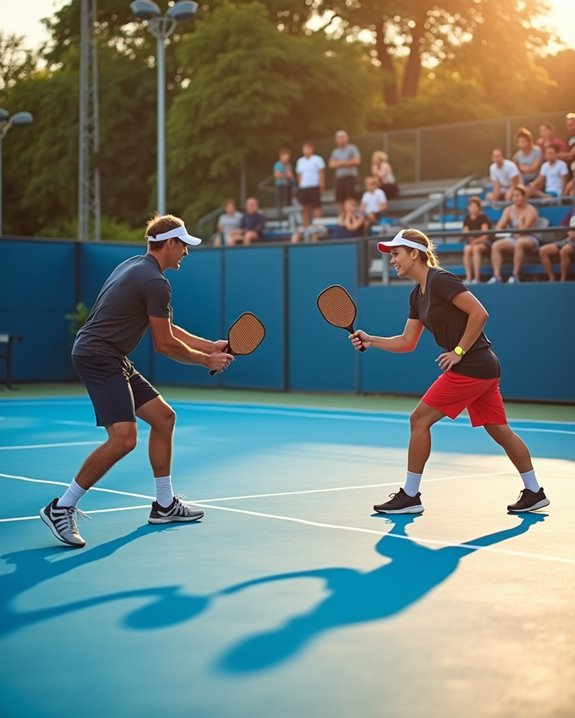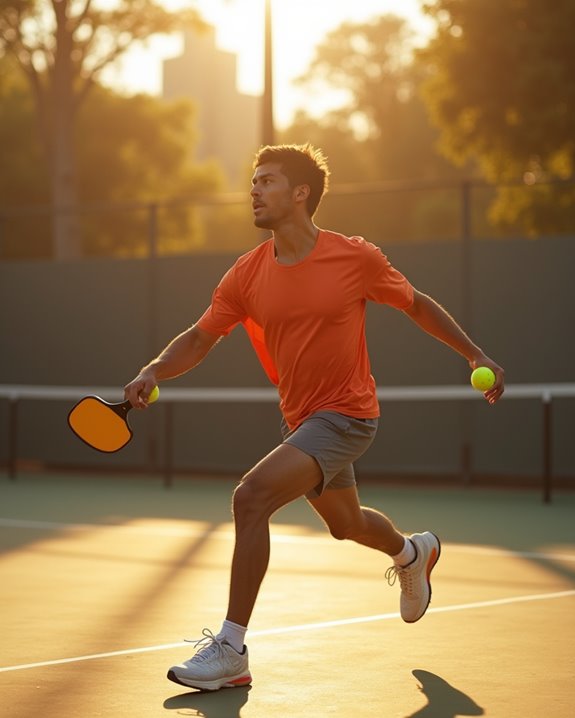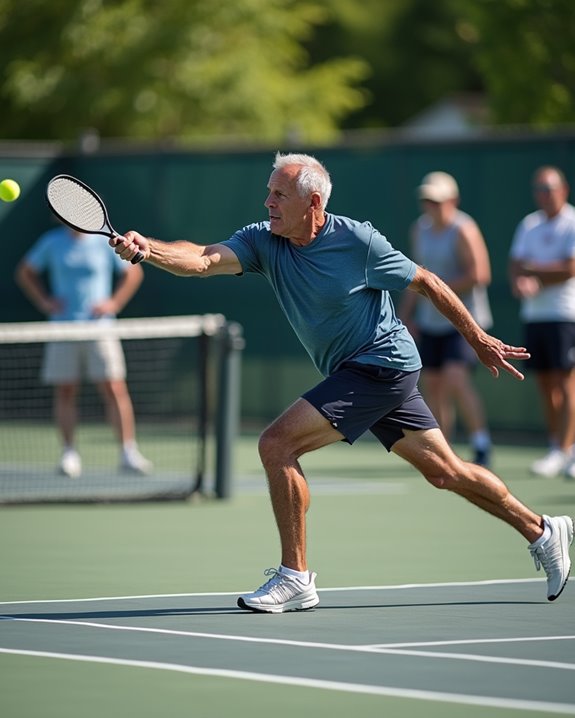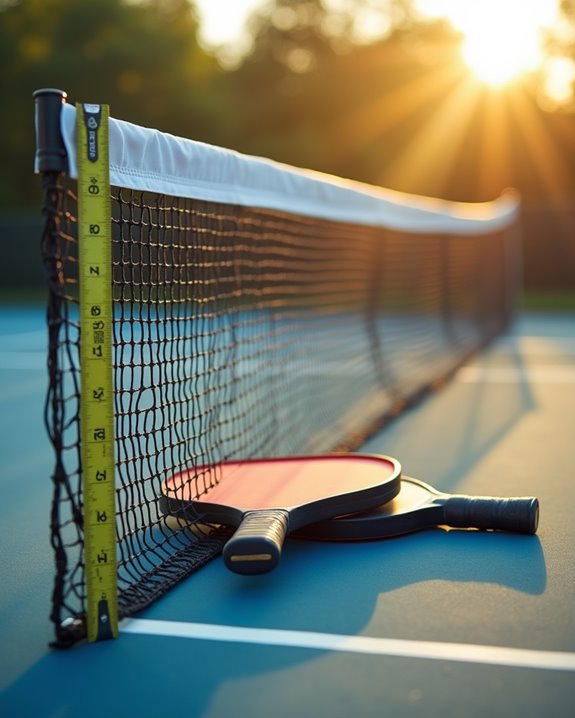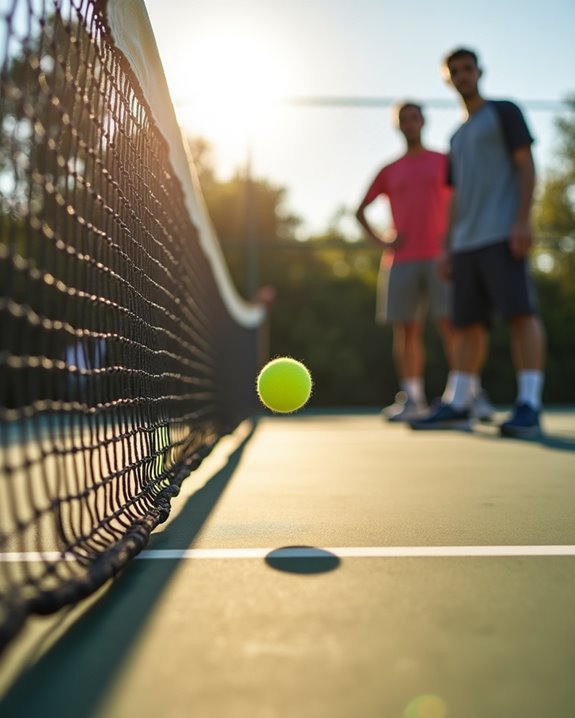Pickleball stacking is your secret sauce for gaining court advantage! By positioning both partners on the same side, you’ll maximize your stronger player’s forehand shots while creating confusion for opponents. You’ll need precise timing—like a perfectly risen soufflé—and clear communication signals (“switch” or “stay”) to execute smoothly. Lefty-righty pairings create particularly challenging angles that’ll leave opponents scrambling. Practice your changes regularly to transform your 3.5 game into a well-seasoned 4.0 performance. The following strategies will serve up your competitive edge.
Key Takeaways
- Stacking positions both partners on the same court side to maximize shot selection and optimize the stronger player’s forehand advantage.
- Establish clear verbal cues like “switch” or “stay” and non-verbal signals for seamless communication during fast-paced rallies.
- Initial stacking on the serving side creates strategic advantage, with the stronger player positioned to receive opponent’s returns consistently.
- Defensive stacking creates barriers against opponents and minimizes movement for players with limited mobility.
- Lefty-righty team pairings create challenging angles that disrupt opponents by leveraging each player’s unique strengths.
Numeric List of 9 Second-Level Headings
Before we plunge into the detailed strategies of pickleball stacking, let’s map out our game plan with these nine essential topics we’ll cover:
- Understanding Stacking Fundamentals
- When to Implement Stacking Strategy
- Communicating with Your Partner
- Right-Side Dominant Techniques
- Left-Side Dominant Approaches
- Shifting from Defense to Offense
- Countering Opponent’s Stacking Maneuvers
- Mixing and Folding Your Strategies
- Practicing Stacking Drills
These headings will serve as your recipe for success on the court. You’ll learn to blend positioning with timing—just like folding ingredients into a perfect soufflé. The sizzle of a well-executed stack can transform your game from bland to gourmet. Let’s prepare to serve up some unbeatable stacking combinations!
What Is Pickleball Stacking and Why It Matters
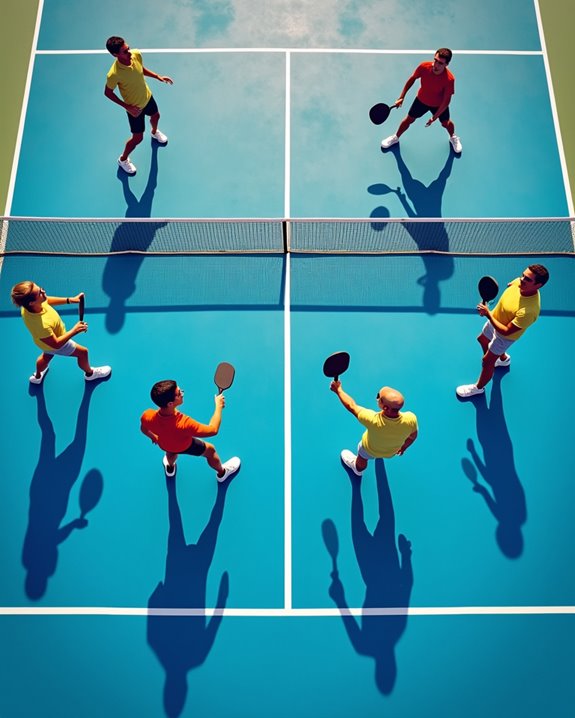
Pickleball stacking, like a secret sauce in your competitive recipe, transforms ordinary doubles play into a strategic masterpiece. This technique involves both partners positioning themselves on the same side of the court to maximize shot selection and coverage.
Think of pickleball stacking as plating a gourmet dish—you’re arranging players to showcase your team’s strongest flavors. When executed properly, you’ll enable your power player to utilize their crisp forehand shots while covering more court territory.
Strategic player positioning transforms ordinary doubles into a masterpiece, spotlighting your team’s strongest shots while maximizing court coverage.
The beauty of stacking? It confuses opponents, disrupting their rhythm like an unexpected spice in a familiar dish. You’ll force unforced errors while protecting your weaker shots.
With proper communication between partners, pickleball stacking can elevate your game from mild to sizzling, potentially boosting your rating from 3.5 to 4.0.
The Science Behind Effective Stacking Strategies
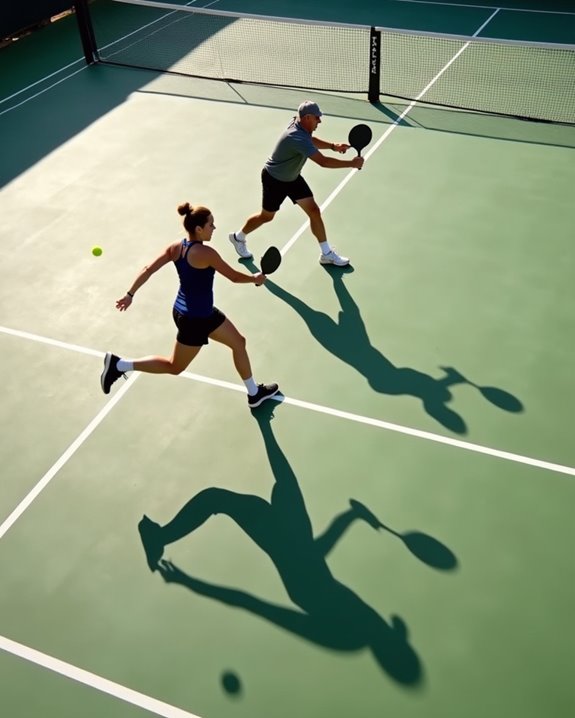
While many recreational players view stacking as mere court positioning, the deeper mechanics resemble a perfectly balanced recipe with precisely measured ingredients. Like a chef analyzing flavor profiles, you’ll need to study your opponents’ tendencies to create the perfect stacking formula.
Your ingredients include player strengths (the protein), court coverage (the base), and strategic communication (the seasoning). When you position your stronger player to utilize their forehand on the right side, you’re fundamentally creating your signature dish.
The secret sauce? Adapting your stacking approach based on what you observe. If you notice opponents struggling against specific shots, adjust your recipe accordingly. Regular practice will help you perfect this technique—folding in coordinated movements that disrupt opponents while maximizing your team’s effectiveness.
Assessing Team Strengths for Optimal Stacking Positions
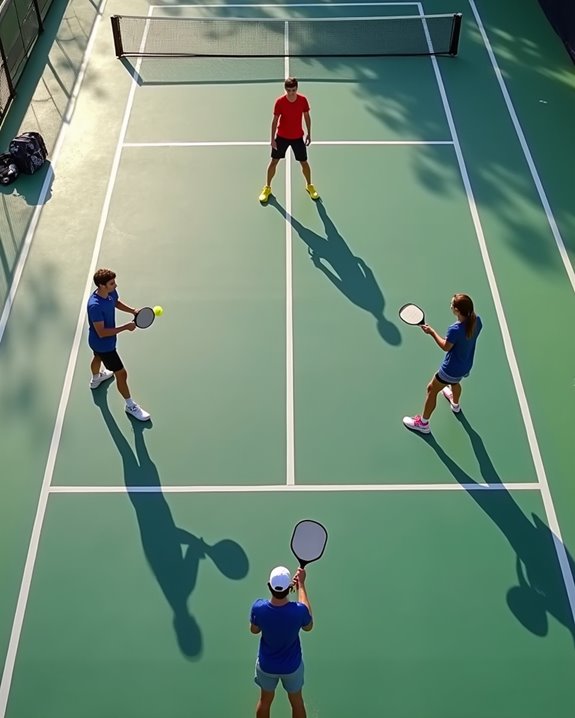
Just as a master chef selects the finest ingredients before creating a signature dish, you’ll need to carefully evaluate your team’s strengths to craft the perfect stacking recipe. This strategic positioning technique begins with a thorough assessment of each player’s forehand and backhand capabilities.
Position your power player on their forehand side—it’s like placing your sharpest knife where it’ll slice through opposition most effectively. Consider mobility too; if your partner moves like molasses, arrange your formation to minimize their court coverage.
Don’t forget to taste-test against your opponents! Study their tendencies and adjust your positioning to exploit weaknesses. Like chefs tasting throughout preparation, you and your partner should communicate constantly, making real-time adjustments when your initial recipe isn’t producing the desired results. Additionally, consider the impact of paddle weight and balance on your gameplay, as it can significantly influence your team’s performance during matches.
Mastering Offensive Stacking Techniques
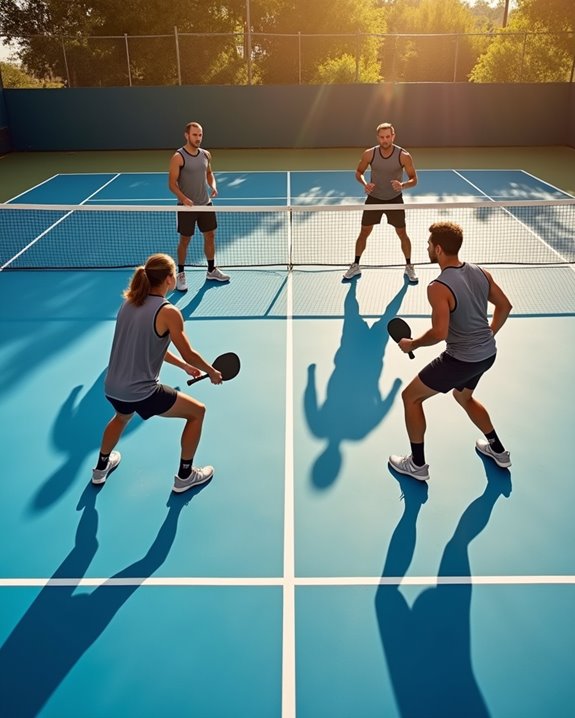
Now that you’ve identified your team’s unique flavor profile, it’s time to spice up your game with offensive stacking—the secret sauce of competitive pickleball.
Position your stronger player on the forehand side to maximize their dominant shot’s impact. When serving from the right, both players can initially stack on that side, creating a strategic advantage like a chef’s perfectly arranged mise en place.
After your serve, the recipe changes: your weaker player should slide to the left while your power player remains in position to release forehand winners. The key ingredient? Ensuring your stronger player consistently receives your opponent’s returns.
With regular practice, this offensive stacking technique will elevate your gameplay from mild 3.5 to spicy 4.0, leaving opponents scrambling to adjust their defensive menu.
Defensive Stacking Approaches for Better Court Coverage
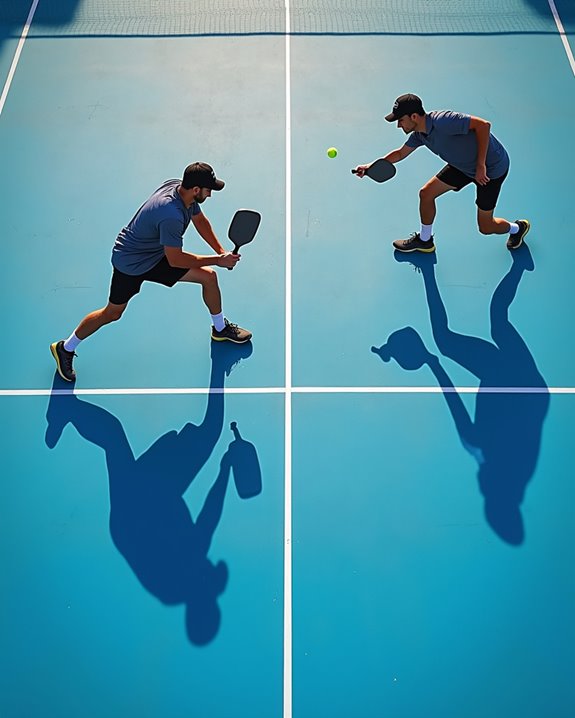
As offense sizzles with strategy, defense requires its own special recipe for success. Defensive stacking positions both players on the same side of the court, creating a barrier that’s tough for opponents to crack.
You’ll find this formation particularly flavorful when one partner has limited mobility—it minimizes their movement while allowing your stronger player to cover more ground, like a chef efficiently managing their kitchen space.
To serve up this strategy effectively:
Tactical defensive serving requires clear communication, deceptive positioning and consistent practice—the essential ingredients for outmaneuvering aggressive opponents.
- Simmer in constant communication—call out switches clearly
- Blend your positioning to confuse opponents and force unforced errors
- Whisk together regular practice sessions to perfect your coordination
When properly prepared, defensive stacking creates a cohesive team that can respond quickly to aggressive shots, turning your opponents’ heat into your advantage.
Communication Protocols During Stacking Transitions
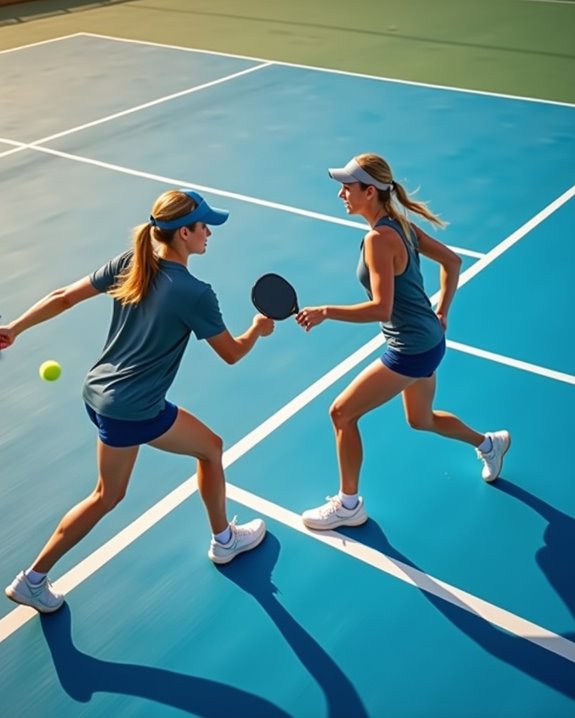
While kitchen chaos erupts during fast-paced pickleball exchanges, your stacking strategy can collapse without proper communication protocols. Like a well-coordinated kitchen brigade, you’ll need a recipe for clear signals that both partners understand instantly.
Establish consistent verbal cues—”switch” or “stay”—immediately after your opponents serve. These short, punchy commands work like timer dings, alerting your partner to the next move. Supplement these with non-verbal signals—a quick hand gesture or eye contact—when the rally gets too spicy for words.
Don’t let your communication simmer too long! Call your positions early, allowing both players to smoothly fold into their spots. Practice these protocols regularly during drills, and you’ll find your shifts becoming as seamless as a perfectly executed soufflé.
Common Stacking Mistakes and How to Avoid Them
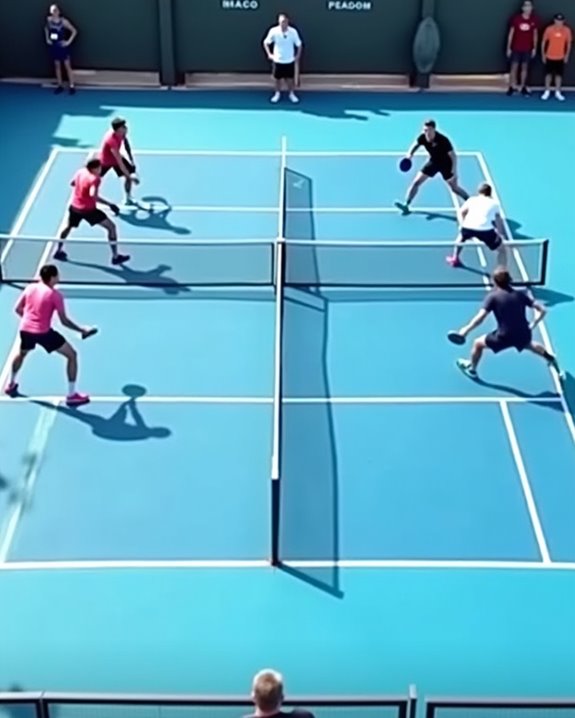
Four critical stacking blunders can turn your pickleball strategy into a recipe for disaster. Like overboiling pasta, poor communication with your partner creates a mushy mess during shifts, spoiling perfectly good opportunities to showcase your strengths.
You’re also likely folding in the wrong ingredients if you’re not adjusting your stacking recipe based on opponents’ playstyles. This leaves gaps in your court coverage—like forgetting to season both sides of your dish!
Many players underestimate the need to marinate their movements through practice, resulting in choppy shifts during matches. Don’t serve up confusion by stacking when both players are equally skilled on both sides. Instead, carefully time your position switches like a chef monitoring a delicate soufflé—too early or too late, and your strategy falls flat.
Adapting Your Stacking Strategy to Different Opponents
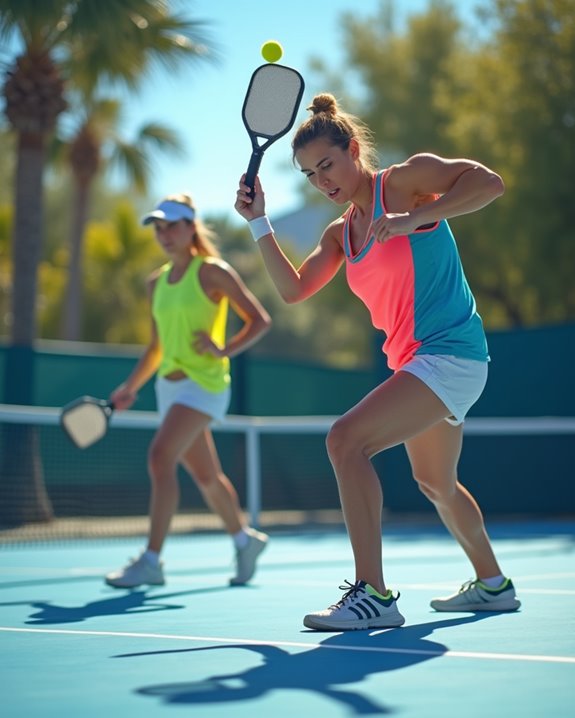
Now that you’ve learned what not to do, it’s time to expand your pickleball recipe book by tailoring your stacking approach to different opponents. Think of your stacking strategy as a signature dish that needs adjusting based on who’s at the table.
First, sample your opponents’ play style—do they serve a powerful forehand or struggle with backhand returns? Position your stronger player to exploit these weaknesses, like garnishing a dish where it creates the most impact.
If you’re fortunate to have a lefty-righty combination on your team, use this flavor pairing to create challenging angles that force opponents to scramble.
Don’t let your strategy simmer too long without tasting! Communicate with your partner and adjust your positions based on real-time observations, ensuring your stacking strategy remains fresh and responsive throughout the match.
Frequently Asked Questions
How to Remember Stacking in Pickleball?
Remember stacking techniques by positioning the stronger player’s forehand centrally. Use signals with your partner, practice shifts during drills, and create mental triggers like “Stack Strong” to reinforce proper positioning during gameplay.
What Is the Golden Rule of Pickleball?
Over 80% of new players initially struggle with this concept! The Golden Principle of pickleball requires that the ball must bounce once on each side after serving before you’re allowed to volley it.
What Is the Best Pickleball Strategy?
The best pickleball strategy is implementing an offensive formation through stacking. You’ll want to position your stronger player strategically, communicate effectively with your partner, and adapt your approach based on your opponents’ weaknesses.
What Is the Advantage of Stacking in Pickleball?
Did you know 72% of elite doubles teams use stacking? You’ll gain significant stacking benefits by positioning your stronger player on their forehand side, creating advantageous angles, and preventing opponents from targeting your weaker player.

